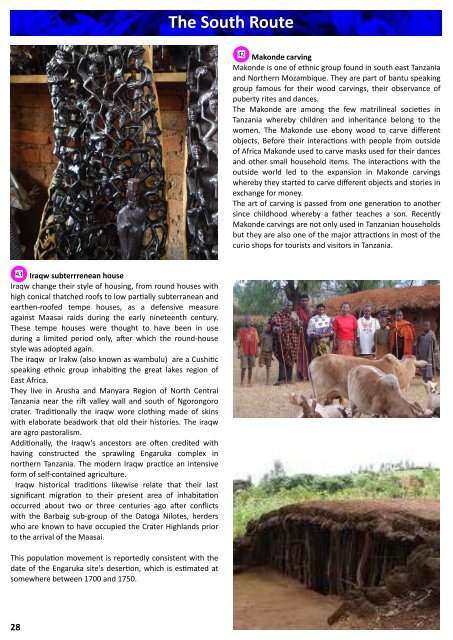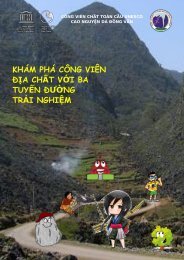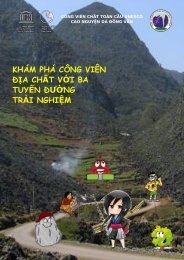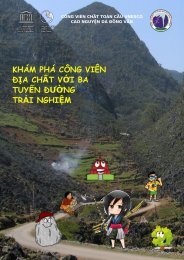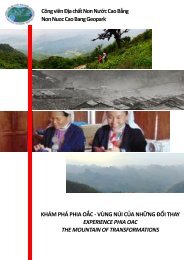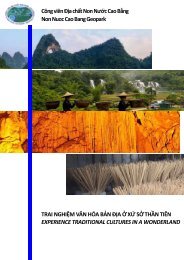Create successful ePaper yourself
Turn your PDF publications into a flip-book with our unique Google optimized e-Paper software.
The South North Route route<br />
42<br />
Makonde carving<br />
Makonde is one of ethnic group found in south east Tanzania<br />
and Northern Mozambique. They are part of bantu speaking<br />
group famous for their wood carvings, their observance of<br />
puberty rites and dances.<br />
The Makonde are among the few matrilineal sociees in<br />
Tanzania whereby children and inheritance belong to the<br />
women. The Makonde use ebony wood to carve different<br />
objects, Before their interacons with people from outside<br />
of Africa Makonde used to carve masks used for their dances<br />
and other small household items. The interacons with the<br />
outside world led to the expansion in Makonde carvings<br />
whereby they started to carve different objects and stories in<br />
exchange for money.<br />
The art of carving is passed from one© generaon www.coolgeography.co.uk to another<br />
since childhood whereby a father teaches a son. Recently<br />
Makonde carvings are not only used in Tanzanian households<br />
but they are also one of the major aracons in most of the<br />
curio shops for tourists and visitors in Tanzania.<br />
43 Iraqw subterrrenean house<br />
Iraqw change their style of housing, from round houses with<br />
high conical thatched roofs to low parally subterranean and<br />
earthen-roofed © Family Leakeytempe houses, as a defensive measure<br />
against Maasai raids during the early nineteenth century.<br />
These tempe houses were thought to have been in use<br />
during a limited period only, aer which the round-house<br />
style was adopted again.<br />
The iraqw or Irakw (also known as wambulu) are a Cushic<br />
speaking ethnic group inhabing the great lakes region of<br />
East Africa.<br />
They live in Arusha and Manyara Region of North Central<br />
Tanzania near the ri valley wall and south of Ngoro<strong>ngo</strong>ro<br />
crater. Tradionally the iraqw wore clothing made of skins<br />
with elaborate beadwork that old their histories. The iraqw<br />
are agro pastoralism.<br />
Addionally, the Iraqw's ancestors are oen c<strong>red</strong>ited with<br />
having constructed the sprawling Engaruka complex in<br />
northern Tanzania. The modern Iraqw pracce an intensive<br />
form of self-contained agriculture.<br />
Iraqw historical tradions likewise relate that their last<br />
significant migraon to their present area of inhabitaon<br />
occur<strong>red</strong> about two or three centuries ago aer conflicts<br />
with the Barbaig sub-group of the Datoga Nilotes, herders<br />
who are known to have occupied the Crater Highlands prior<br />
to the arrival of the Maasai.<br />
Family Leakey and friends inside the outdoor dining room<br />
©endorolodge.com<br />
This populaon movement is reportedly consistent with the<br />
date of the Engaruka site's deseron, which is esmated at<br />
somewhere between 1700 and 1750.<br />
©wikimedia commons<br />
28


